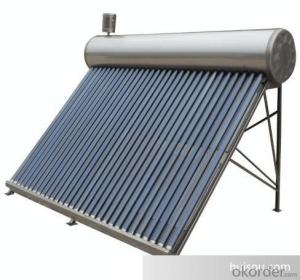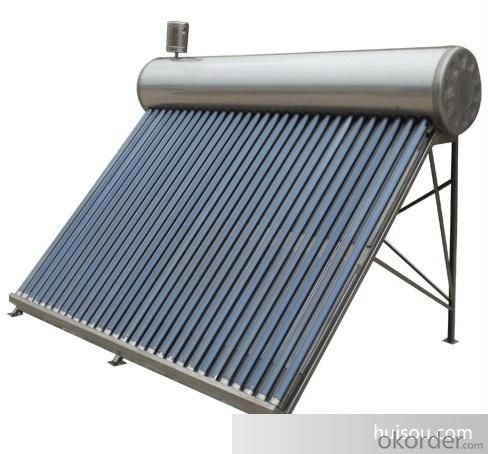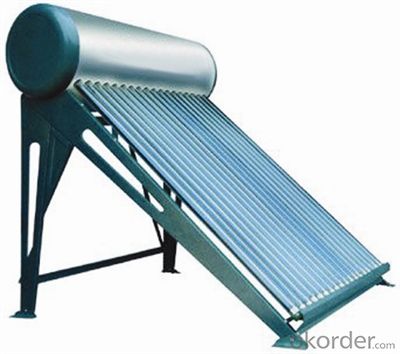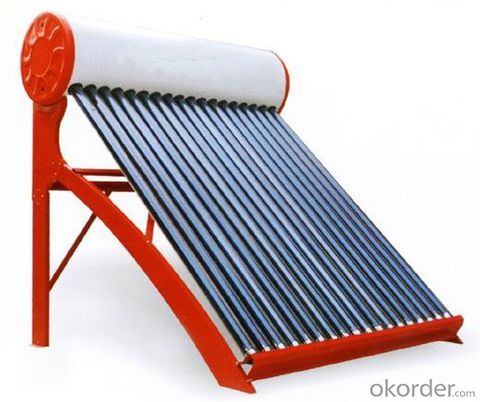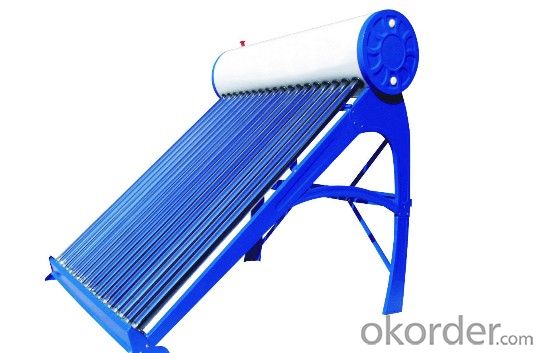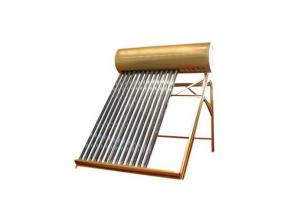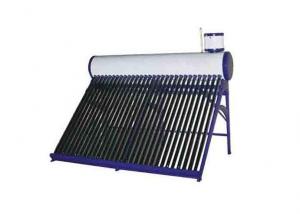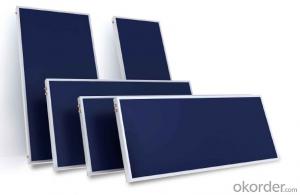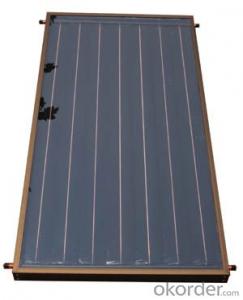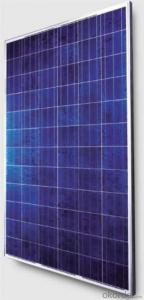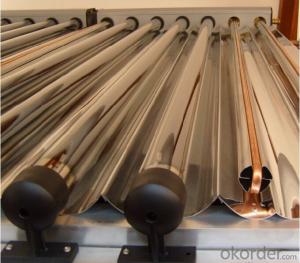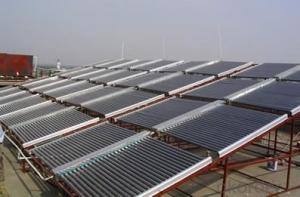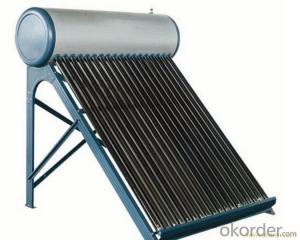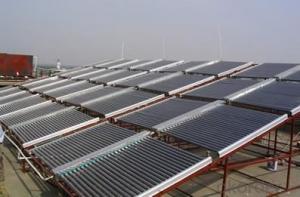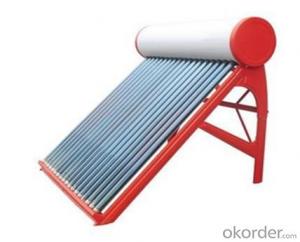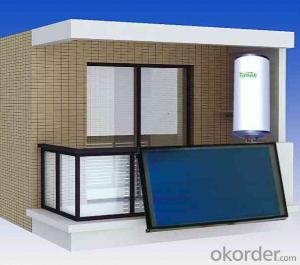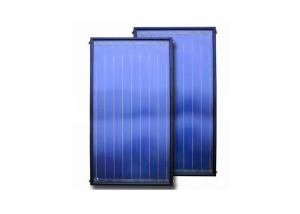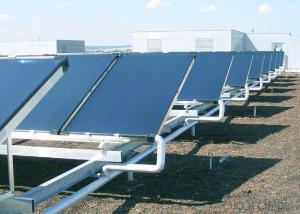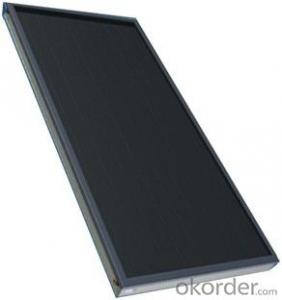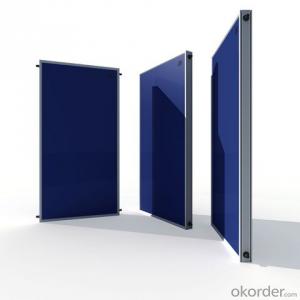1 2 Sphere Solar Collectors Heat Pipe Copper Solar Water Heater System 2024 New Design
- Loading Port:
- China main port
- Payment Terms:
- TT OR LC
- Min Order Qty:
- 1 set
- Supply Capability:
- 6000 set/month
OKorder Service Pledge
OKorder Financial Service
You Might Also Like
Introduction of Non-Pressure Solar Water Heater:
Non-pressure Solar Heater is one of the most economical solar water heating device with pretty high efficiency at the same time. It consists of hot water storage tank, solar vacuum tubes with mouth plug in storage tank, and bracket supporting tank and tubes.When cold water in evacuated tubes is heated with solar irradiation, as the specific gravities of hot water and cold water are different, hotter water goes upward to storage tank and colder water goes downward to glass tubes. through this continuous circulation, the cold water in storage tank will be gradually heated till sunset.
Specialty:
1. High thermal performance and working temperature: the heat exchanging rate even in winter can up above 55%.
2. Heat collecting efficiency is at least 20% above common solar systems.
3. Work in all day and all season: no matter any corner of the world, this system can work well even -40℃ to avoid the tube freezing problem.
4. Reliability: No water following through the tube, so water scale can not generate and tube cracks could be avoided, the system still can keep working even with some damaged tubes.
5. It can connect with water tap and work automatically with pressure0.6Mpa, bring enjoyable washing experience.
6. Safety: P/T valve would release pressure and temperature to protect tank..
Technical Specification:
1. Outer tank material: SUS304 stainless steel or powder coated color steel
2. Inner tank material: 1.2mm thick SUS304 food grade stainless steel ( Optional material SUS316L)
3. Vacuum tube material: borosilicate glass 3.3; AL-SS-CU absorb coating, with copper heat pipe inside
4. Frame material: 1.2mm thickness stainless steel
5. Insulation material: 55mm thickness polyurethane
6. Suitable for mains pressure water(up to 8 bar/116psi)
7. Easy plug-in installation
8. Install the T/P valve on the pressurized tank
9. Seal material: Stabilized High Temperature Silicon
Outer tank material: SUS304 stainless steel or powder coated color steel
Inner tank material: 1.2mm thick SUS304 food grade stainless steel ( Optional material SUS316L)
Vacuum tube material: borosilicate glass 3.3; AL-SS-CU absorb coating, with copper heat pipe inside
Frame material: 1.2mm thickness stainless steel
Insulation material: 55mm thickness polyurethane
Suitable for mains pressure water(up to 8 bar/116psi)
Easy plug-in installation
Install the T/P valve on the pressurized tank
Seal material: Stabilized High Temperature Silicon
19. Vacuum Tube | 20. Size (mm) | 21. Φ47*1500 / Φ58*1800 / Φ70*2100 | |||||
22. Tube (pcs) | 23. 10 / 12 / 15 / 18 / 20 / 22 / 24 / 30 / 36 / 42 | ||||||
24. Material | 25. Borosilicate 3.3 glass, magnetron spluttering selective coating | ||||||
26. Coating | 27. Single-target AL-N/AL or Three-target AL/N-Cu-SS | ||||||
28. Water Tank | 29. Capacity | 30. 80L ~ 500L for hot water storage tank | |||||
31. Inner tank | 32. Food-grade stainless steel SUS304-2B / SUS316 | ||||||
33. Insulation | 34. High-density polyurethane foam with 70~80 hour heat preservation | ||||||
35. Tank shell | 36. Food-grade stainless steel SUS304-2B | ||||||
37. Bracket | 38. Shaped strong aluminum alloy structure adaptable for flat or slope roof | ||||||
39. Accessories | 40. Anti-aging silicon seals, Dustproof seals, Air-vent cap, Stainless screws | ||||||
41. Auxiliary Devices | 42. Assistant tank, Intelligent controller, Electrical heater, Magnesium anodes | ||||||
43. Tilt Angle | 44. 25 ~ 50° | ||||||
45. Water Output | 46. 45 - 95°C | ||||||
47. Hail Resistance | 48. Φ25mm diameter | ||||||
49. Model Number | 50. Solar Vacuum Tube | 51. Tank 52. Liter | 53. System 54. Liter | 55. Container Loading Qty /sets | |||
56. Size /mm | 57. Qty /pcs | 58. 20GP | 59. 40GP | 60. 40HQ | |||
61. VNS-58SA12-100 | 62. Φ58*1800 | 63. 12 | 64. 100 | 65. 132 | 66. 58 | 67. 119 | 68. 140 |
69. VNS-58SA15-130 | 70. 15 | 71. 130 | 72. 170 | 73. 54 | 74. 108 | 75. 131 | |
76. VNS-58SA18-150 | 77. 18 | 78. 150 | 79. 198 | 80. 43 | 81. 86 | 82. 105 | |
83. VNS-58SA20-170 | 84. 20 | 85. 170 | 86. 223 | 87. 40 | 88. 80 | 89. 97 | |
VNS-58SA24-200 | 24 | 200 | 263 | 35 | 70 | 85 | |
VNS-58SA30-250 | 30 | 250 | 329 | 28 | 56 | 68 | |
VNS-58SA36-300 | 36 | 300 | 395 | 23 | 47 | 57 | |
Product Show
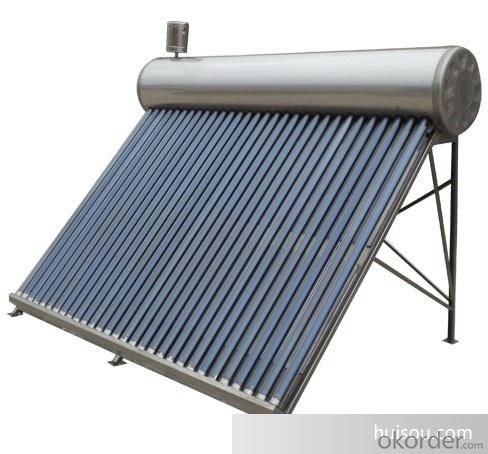
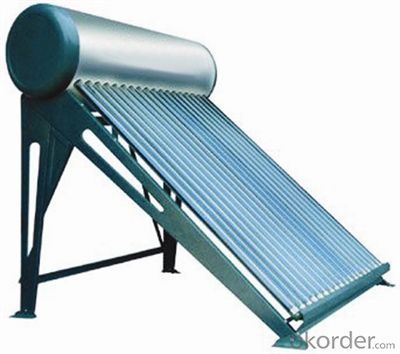
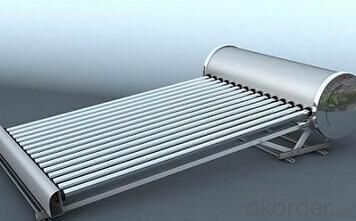
Our Services
1. OEM service
2. Warranty: 5 years
3. Considerable after sale service
Color steel Compact pressure Thermal solar heater
FAQ:
1. What’s the delivery time?
10 days after receiving deposit.
2. How long is the warranty?
5 years for whole system, 1 year for accessory
3. What’s your production capacity?
6000sets/month
4. What’s the MOQ?
1 set.
5. What’s your payment term?
Container: 30% T/T in advance for deposit, 70% T/T before shipment for fist order.
70% T/T after seeing copy of B/L from second order
Sample: 100% T/T in advance
Other choices: L/C at sight.
6. What certifications do you have?
CE, SOLAR KEYMARK, SRCC and etc.
- Q: Can solar collectors be used for heating saunas?
- Yes, solar collectors can be used for heating saunas. Solar thermal collectors, also known as solar water heaters, can be connected to the sauna's heating system to provide heat. These collectors use the sun's energy to heat water, which is then circulated through the sauna's heating system to warm up the sauna. This is an eco-friendly and cost-effective way to heat saunas, as it utilizes renewable energy sources.
- Q: Can solar collectors be used for generating electricity on beaches?
- Yes, solar collectors can be used for generating electricity on beaches. Solar collectors can be installed on the beach or nearby areas to harness the sun's energy and convert it into electricity. This can provide a sustainable and clean source of power for various beach-related activities such as lighting, charging stations, or even powering small appliances.
- Q: Can solar collectors be used in chemical plants?
- Yes, solar collectors can be used in chemical plants. Solar collectors capture and convert solar energy into heat or electricity, which can be utilized for various industrial processes. In chemical plants, solar collectors can be employed for thermal applications such as heating water or other fluids, providing process heat for reactions or distillation, or even generating steam for power generation. These applications can help reduce reliance on conventional energy sources, lower energy costs, and decrease greenhouse gas emissions. Additionally, solar collectors can be integrated with existing systems or used in conjunction with other renewable energy sources to create a more sustainable and environmentally friendly operation in chemical plants.
- Q: Can solar collectors be used in cloudy climates?
- Yes, solar collectors can still be used in cloudy climates. While the efficiency of solar collectors may be reduced in cloudy conditions, they can still generate some amount of energy from diffuse sunlight. Additionally, advancements in technology have led to the development of more efficient solar panels that can generate electricity even in low light conditions.
- Q: Are there any limitations on the slope or angle of solar collectors?
- Yes, there are limitations on the slope or angle of solar collectors. The ideal angle for solar collectors is typically between 30 and 45 degrees, depending on the latitude of the installation site. This angle allows for optimal solar energy absorption throughout the year. However, solar collectors can still be effective at different angles, but their efficiency may vary. It's important to consider factors such as the geographical location, seasonal variations, and the specific application when determining the best slope or angle for solar collectors.
- Q: Can solar collectors be used for heating livestock barns?
- Yes, solar collectors can be used for heating livestock barns. Solar collectors can harness solar energy and convert it into heat, which can then be used to warm up the barns and create a comfortable environment for the livestock. This not only helps to reduce energy costs but also promotes sustainability by utilizing renewable energy sources.
- Q: Can solar collectors be used for heating warehouses and storage facilities?
- Yes, solar collectors can be used for heating warehouses and storage facilities. Solar thermal collectors, such as flat plate collectors or evacuated tube collectors, can capture solar energy and convert it into heat. This heat can be utilized for space heating or for heating water in the facility. By installing solar collectors on rooftops or open areas near the warehouse, the facility can benefit from renewable energy to reduce heating costs and decrease reliance on fossil fuels.
- Q: Can solar collectors be used for heating public transportation stations?
- Yes, solar collectors can be used for heating public transportation stations. Solar thermal systems can effectively capture and utilize solar energy to provide heating for these stations. This renewable energy source can reduce the reliance on fossil fuels and contribute to a more sustainable and environmentally friendly transportation infrastructure.
- Q: Can solar collectors be used for generating electricity on data centers?
- Yes, solar collectors can be used for generating electricity on data centers. Solar collectors, also known as solar panels, convert sunlight into electricity through the photovoltaic effect. They consist of multiple solar cells that capture the sun's energy and convert it into direct current (DC) electricity. This electricity can then be converted into alternating current (AC) electricity through inverters, which is the standard form of electricity used in most buildings and data centers. Data centers have a significant energy demand due to the extensive amount of computer servers and cooling systems required for their operation. By installing solar collectors on the rooftops or surrounding areas of data centers, a portion or even the entirety of their electricity needs can be met through solar power. This has several advantages. Firstly, solar energy is a renewable and clean source of electricity. By utilizing solar collectors, data centers can reduce their reliance on fossil fuels and decrease their carbon footprint, contributing to a more sustainable and environmentally friendly operation. Secondly, solar energy can provide a reliable and stable source of electricity. Data centers require a constant power supply to ensure uninterrupted operations. Solar panels can be integrated with battery storage systems, allowing excess energy generated during the day to be stored and used during periods of insufficient sunlight or high electricity demand. This enables data centers to maintain a consistent and reliable power supply. Thirdly, solar energy can offer cost savings for data centers in the long run. Although the initial investment for installing solar collectors can be significant, the operational costs of solar energy are relatively low. Once installed, solar panels have a lifespan of several decades, requiring minimal maintenance. By reducing or eliminating their dependence on grid electricity, data centers can potentially save on utility bills and achieve long-term cost savings. In summary, solar collectors can indeed be used for generating electricity on data centers. By harnessing the power of the sun, data centers can reduce their environmental impact, ensure a reliable power supply, and potentially achieve cost savings. As solar technology continues to advance and become more efficient, it is likely to become an increasingly popular and viable option for powering data centers.
- Q: Can solar collectors be used for generating electricity on electric vehicle charging stations?
- Yes, solar collectors can be used for generating electricity on electric vehicle charging stations. By installing solar panels or collectors on the charging stations' rooftops or nearby areas, the energy from the sun can be harnessed and converted into electricity to charge electric vehicles. This renewable energy source can help reduce reliance on the grid and decrease carbon emissions associated with charging electric vehicles.
Send your message to us
1 2 Sphere Solar Collectors Heat Pipe Copper Solar Water Heater System 2024 New Design
- Loading Port:
- China main port
- Payment Terms:
- TT OR LC
- Min Order Qty:
- 1 set
- Supply Capability:
- 6000 set/month
OKorder Service Pledge
OKorder Financial Service
Similar products
Hot products
Hot Searches
Related keywords
